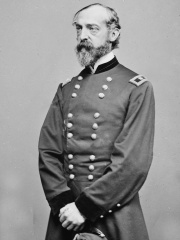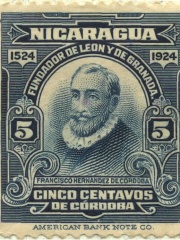
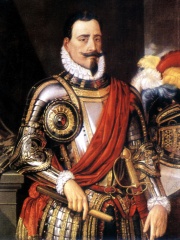
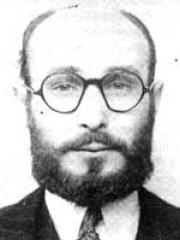
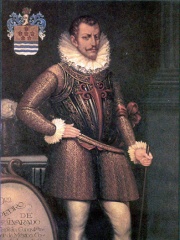
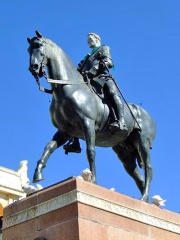
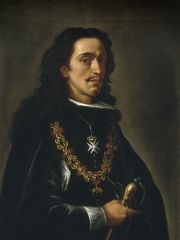
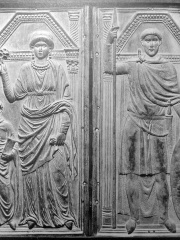
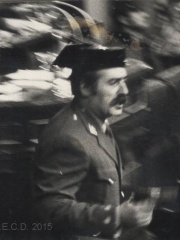
The Most Famous
MILITARY PERSONNELS from Spain
This page contains a list of the greatest Spanish Military Personnels. The pantheon dataset contains 2,058 Military Personnels, 36 of which were born in Spain. This makes Spain the birth place of the 13th most number of Military Personnels behind Italy, and Türkiye.
Top 10
The following people are considered by Pantheon to be the top 10 most legendary Spanish Military Personnels of all time. This list of famous Spanish Military Personnels is sorted by HPI (Historical Popularity Index), a metric that aggregates information on a biography's online popularity. Visit the rankings page to view the entire list of Spanish Military Personnels.

1. Roland (736 - 778)
With an HPI of 77.29, Roland is the most famous Spanish Military Personnel. His biography has been translated into 55 different languages on wikipedia.
Roland (French pronunciation: [ʁɔ.lɑ̃]; Old Frankish: *Hrōþiland; Medieval Latin: Hruodlandus or Rotholandus; Italian: Orlando or Rolando; died 15 August 778) was a Frankish military leader under Charlemagne who became an epic hero and one of the principal figures in the literary cycle known as the Matter of France. The historical Roland was military governor of the Breton March, responsible for defending Francia's frontier against the Bretons. His only historical attestation is in Einhard's Vita Karoli Magni, which notes he was part of the Frankish rearguard killed in retribution by the Basques in Iberia at the Battle of Roncevaux Pass. The story of Roland's death at Roncevaux Pass was embellished in later medieval and Renaissance literature. The first and most famous of these epic treatments was the Old French Chanson de Roland of the 11th century. Two masterpieces of Italian Renaissance poetry, the Orlando Innamorato and Orlando Furioso (by Matteo Maria Boiardo and Ludovico Ariosto, respectively), are even further detached from history than the earlier Chansons, similarly to the later Morgante by Luigi Pulci. Roland is poetically associated with his sword Durendal, his horse Veillantif, and his oliphant horn. In the late 17th century, French Baroque composer Jean-Baptiste Lully wrote an opera titled Roland, based on the story of the title character.

2. Pedro de Valdivia (1497 - 1553)
With an HPI of 71.09, Pedro de Valdivia is the 2nd most famous Spanish Military Personnel. His biography has been translated into 46 different languages.
Pedro Gutiérrez de Valdivia or Valdiva (Spanish pronunciation: [ˈpeðɾo ðe βalˈdiβja]; April 17, 1497 – December 25, 1553) was a Spanish conquistador and the first Governor of Colonial Chile. After having served with the Spanish army in Italy and Flanders, he was sent to South America in 1535, where he served as a soldier under the Pizarro brothers in Peru, gradually rising in power. In 1540, Valdivia led an expedition of 150 Spaniards and 1,000 Peruvian Indians into Chile, where he defeated a large force of indigenous warriors and founded Santiago in 1541. He extended Spanish rule south to the Biobío River in 1546, fought again in Peru (1546–1548), and returned to Chile as Royal Governor in 1549. In 1550, he expanded Spanish rule further south into Araucanía, where he founded the city of Concepción and the eponymous city of Valdivia. He was captured and killed by Mapuche Indians during the Arauco War in 1553.

3. Juan Pujol García (1912 - 1988)
With an HPI of 71.09, Juan Pujol García is the 3rd most famous Spanish Military Personnel. His biography has been translated into 30 different languages.
Juan Pujol García (Spanish: [ˈxwan puˈʝol ɣaɾˈθi.a]; 14 February 1912 – 10 October 1988), also known as Joan Pujol i García (Catalan: [ʒuˈan puˈʒɔl i ɣəɾˈsi.ə]), was a Spanish spy who acted as a double agent loyal to the United Kingdom against Nazi Germany during World War II, when he relocated to Britain to carry out fictitious spying activities for the Germans. He was given the codename Garbo by the British; their German counterparts codenamed him Alaric and referred to his non-existent spy network as "Arabal". After developing a loathing of political extremism of all sorts during the Spanish Civil War, Pujol decided to become a spy for Britain as a way to do something "for the good of humanity." Pujol and his wife contacted the British Embassy in Madrid, which rejected his offer. Undeterred, he created a false identity as a fanatically pro-Nazi Spanish government official and successfully became a German agent. He was instructed to travel to Britain and recruit additional agents; instead he moved to Lisbon and created bogus reports about Britain from a variety of public sources including a tourist guide to Britain, train timetables, cinema newsreels, and magazine advertisements. Although the information would not have withstood close examination, Pujol soon established himself as a trustworthy agent. He began inventing fictitious sub-agents who could be blamed for false information and mistakes. The Allies finally accepted Pujol when the Germans expended considerable resources attempting to hunt down a fictitious convoy. Following interviews by Desmond Bristow of Section V MI6 Iberian Section, Pujol was taken on. The family were moved to Britain and Pujol was given the code name "Garbo". Pujol and his handler Tomás Harris spent the rest of the war expanding the fictitious network, communicating to the German handlers at first by letters and later by radio. Eventually the Germans were funding a network of 27 agents, all fictitious. Pujol had a key role in the success of Operation Fortitude, the deception operation intended to mislead the Germans about the timing, location, and scale of the invasion of Normandy in 1944. The false information Pujol supplied helped persuade the Germans that the main attack would be in the Pas de Calais, so that they kept large forces there before and even after the invasion. Pujol had the distinction of receiving military decorations from both sides of the war – being awarded the Iron Cross and later becoming a Member of the Order of the British Empire.

4. Pedro de Alvarado (1485 - 1541)
With an HPI of 70.84, Pedro de Alvarado is the 4th most famous Spanish Military Personnel. His biography has been translated into 44 different languages.
Pedro de Alvarado (Spanish pronunciation: [ˈpeðɾo ðe alβaˈɾaðo]; c. 1485 – 4 July 1541) was a Spanish conquistador, adelantado, governor and captain general of Guatemala. He participated in the conquest of Cuba, in Juan de Grijalva's exploration of the coasts of the Yucatán Peninsula and the Gulf of Mexico, and in the conquest of the Aztec Empire led by Hernán Cortés. He is considered the conquistador of much of Central America, including Guatemala, Honduras, El Salvador, and parts of Nicaragua. While a great warrior, Alvarado developed a reputation for greed and cruelty, and was accused of various crimes and abuses by natives and Spaniards alike. In 1541, Alvarado was crushed by a horse while attempting to quell a native revolt in Mexico, dying a few days later.
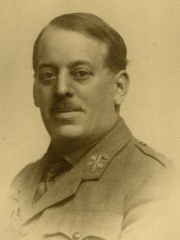
5. José Sanjurjo (1872 - 1936)
With an HPI of 67.37, José Sanjurjo is the 5th most famous Spanish Military Personnel. His biography has been translated into 31 different languages.
José Sanjurjo y Sacanell (Spanish: [saŋˈxuɾxo]; 28 March 1872 – 20 July 1936) was a Spanish military officer who was one of the military leaders who plotted the July 1936 coup d'état that started the Spanish Civil War. He was endowed the nobiliary title of "Marquis of the Rif" in 1927. A monarchist opponent of the Second Spanish Republic proclaimed in 1931, he led a coup d'état known as la Sanjurjada in August 1932. The authorities easily suppressed the coup and initially condemned Sanjurjo to death, then later commuted his sentence to life imprisonment. The government of Alejandro Lerroux—formed after the 1933 general election—eventually amnestied him in 1934. He took part, from his self-exile in Portugal, in the military plot for the 1936 coup d'état. Following the coup, Sanjurjo, expected by some to become the commander-in-chief of the Nationalist faction, died in an air crash on the third day of the war, when travelling back to Spain. He had chosen to fly in a small, overloaded plane, because the pilot was a friend of his. Sabotage was suspected, but never proven.

6. Gonzalo Fernández de Córdoba (1453 - 1515)
With an HPI of 67.00, Gonzalo Fernández de Córdoba is the 6th most famous Spanish Military Personnel. His biography has been translated into 30 different languages.
Gonzalo Fernández de Córdoba (1 September 1453 – 2 December 1515) was a Spanish general and statesman. He led military campaigns during the Conquest of Granada and the Italian Wars, after which he served as Viceroy of Naples. For his extensive political and military success, he was made Duke of Santángelo (1497), Terranova (1502), Andría, Montalto and Sessa (1507), and earned the nickname El Gran Capitán ("The Great Captain"). Held as one of the greatest generals in history, he became the first European to decisively employ firearms on the battlefield, and among the first to reorganize infantry with pikes and firearms. His extensive combined arms doctrine, which led to the formation of the tercios after his death, were instrumental in making the Spanish army the dominant land force in Europe for over a century and a half. He has been credited with marking the transition between medieval and modern warfare, leaving a lasting influence in military thinking up to the 20th century. Córdoba rose to international prestige during his career in the Italian Wars, maintaining active relationships not only with the crowns of Castile and Aragon, but also with France, the Papal States, the Italian city-states and the Holy Roman Empire, all of which sought out his services. Chronicler Jerónimo Zurita went to consider him "...the most esteemed person that lived in these times, for such princes, either desired to have him for a friend, or were wary that he might become their enemy."

7. John of Austria the Younger (1629 - 1679)
With an HPI of 66.65, John of Austria the Younger is the 7th most famous Spanish Military Personnel. His biography has been translated into 24 different languages.
John Joseph of Austria or John of Austria (the Younger) (Spanish: Don Juan José de Austria; 7 April 1629 – 17 September 1679) was a Spanish general and political figure. He was the only illegitimate son of Philip IV of Spain to be acknowledged by the King and trained for military command and political administration. Don John advanced the causes of the Spanish Crown militarily and diplomatically during the century's crisis, recovering control of Naples, Sicily and Catalonia from local revolts, although failing to advance from only initial victories against France and England in his stint as governor of the Spanish Netherlands from 1656 to 1659. He then failed to quell the revolt of Portugal, which separated from Spain. After his military career, he returned to the court, where his opposition his father's widow, Queen Mariana of Austria, led to a 1677 palace coup through which he exiled Mariana and took control of the monarchy over his young half-brother Charles II of Spain. Don John worked to secure Charles II's international position against the ambitions of Louis XIV of France, although his labour was left unfinished with his death in 1679.

8. Serena (365 - 408)
With an HPI of 65.97, Serena is the 8th most famous Spanish Military Personnel. Her biography has been translated into 20 different languages.
Serena (died 409) was a member of the Theodosian dynasty as the niece of the emperor Theodosius I, as well as the wife of the military commander Stilicho.

9. Antonio Tejero (b. 1932)
With an HPI of 65.79, Antonio Tejero is the 9th most famous Spanish Military Personnel. His biography has been translated into 27 different languages.
Antonio Tejero Molina (born 30 April 1932) is a Spanish former lieutenant colonel of the Guardia Civil. He was the most prominent figure in the failed coup d'état against the newly democratic Spanish government on 23 February 1981 when he stormed the Congress of Deputies with 200 armed Civil Guards. For this reason, he was sentenced to thirty years' imprisonment for the crime of consummated military rebellion, with the aggravating circumstance of recidivism. He had previously been arrested for his involvement in the failed coup attempt during Operation Galaxia in 1978.
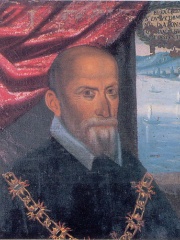
10. Alonso Pérez de Guzmán y Sotomayor, 7th Duke of Medina Sidonia (1550 - 1615)
With an HPI of 65.70, Alonso Pérez de Guzmán y Sotomayor, 7th Duke of Medina Sidonia is the 10th most famous Spanish Military Personnel. His biography has been translated into 16 different languages.
Alonso Pérez de Guzmán y de Zúñiga-Sotomayor, 7th Duke of Medina Sidonia, GE (10 September 1550 – 26 July 1615), was a Spanish aristocrat who was most noted for his role as commander of the Spanish Armada that was to attack Southern England in 1588. He was a great-great grandson of Ferdinand II of Aragon. He was one of the wealthiest men in Europe and a patron of the arts. Successful for his prodigious logistic ability, he organized naval defense and commerce in the southern Iberian Peninsula, managing fleets and pioneering the usage of vessels like frigates. Despite this, he was not personally a naval commander, which contributed to the failure of the Spanish Armada, entrusted to him against his judgement. His defective performance during the battle marked his career in late historiography.
People
Pantheon has 36 people classified as Spanish military personnels born between 300 BC and 1932. Of these 36, 1 (2.78%) of them are still alive today. The most famous living Spanish military personnels include Antonio Tejero. The most famous deceased Spanish military personnels include Roland, Pedro de Valdivia, and Juan Pujol García.
Living Spanish Military Personnels
Go to all RankingsDeceased Spanish Military Personnels
Go to all RankingsRoland
736 - 778
HPI: 77.29
Pedro de Valdivia
1497 - 1553
HPI: 71.09
Juan Pujol García
1912 - 1988
HPI: 71.09
Pedro de Alvarado
1485 - 1541
HPI: 70.84
José Sanjurjo
1872 - 1936
HPI: 67.37
Gonzalo Fernández de Córdoba
1453 - 1515
HPI: 67.00
John of Austria the Younger
1629 - 1679
HPI: 66.65
Serena
365 - 408
HPI: 65.97
Alonso Pérez de Guzmán y Sotomayor, 7th Duke of Medina Sidonia
1550 - 1615
HPI: 65.70
George Meade
1815 - 1872
HPI: 64.29
Francisco Hernández de Córdoba
1475 - 1526
HPI: 64.28
Gaius Laelius
300 BC - 200 BC
HPI: 62.84
Overlapping Lives
Which Military Personnels were alive at the same time? This visualization shows the lifespans of the 19 most globally memorable Military Personnels since 1700.

